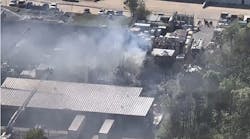Let's look at some myths and attempt to set the record.
MYTH 1: The fire service wants to get into EMS to save jobs because there are fewer fires.
FACT: This statement refers to the fact that fire calls continue to drop throughout the U.S. as a result of stricter building codes, improved fire prevention programs and materials being made of more fire resistive. Are these statements true? Yes and no!
Yes, fires around the nation are down as a result of various programs but, no, the fire service is not responding to EMS to "save jobs." To listen to some, the fire service just got involved in EMS recently! Fire services around the country have been providing a variety of medical services for many years. As an example, the St. Louis Fire Department started running medical calls in 1915 and New York City in the 1930s. Don't forget it was fire-based systems such as Los Angeles County, Seattle, Miami, Jacksonville, FL, and Columbus, OH, that were the innovators in establishing the delivery of advanced life support (ALS) on a scene instead of in a hospital emergency room back in the late 1960s and early 1970s. The television show "Emergency," which typified these programs, debuted in 1971 and it wasn't until 1973, two years later, that the EMS Act was signed into federal law.
True, fires are down. But are total run volumes down? The answer is a definite "no," according to U.S. Fire Administration (USFA) statistics. When one considers the advent of smoke and carbon monoxide detectors, more sprinkler alarms, manual pull stations and hazardous materials incidents, it is easy to see that fires are not the only scope of the fire service. Additionally, manpower and staffing should never be based on run numbers but on geographic area of coverage, response times and risk.
I also believe the fire service is more keenly aware of EMS issues because the paramedic/firefighters of the 1970s and 1980s are now becoming the chief officers of the 1990s. These new chief officers were the same paramedics in the 1970s and '80s who felt frustration when they wanted to do more and expand the scope of the fire service even more in the medical arena and were thwarted by an old-time chief who was set in his ways.
MYTH 2: Fire departments are not as economical when it comes to delivering EMS.
FACT: This theory was put to the test last year when Seminole County, FL, put out a request for proposals (RFP) seeking bids for providing emergency medical services. Seminole County Fire & Rescue, AMR and Rural/Metro all bid on the RFP. Seminole County Fire & Rescue chose to use a full-cost allocation model developed by the International Association of Fire Chiefs (IAFC) to show the true cost of providing EMS. AMR and Rural/Metro used the Arthur Anderson template developed by the American Ambulance Association to show that private ambulance services are more economical when it comes to delivering EMS.
In a quandary as to which was the true model for determining the economies of providing EMS, the Seminole County Board of Commissioners turned to the Deloitte & Touche accounting firm. The conclusion of Deloitte & Touche was that the full-cost allocation model used by Seminole County Fire & Rescue was the truer economic model of providing EMS. This was one factor used in the decision-making process when the board of commissioners voted to give the EMS contract to Seminole County Fire & Rescue. However, even if you accept the myth that fire departments are not economical, what is wrong with the fire service becoming more productive with an already standing army of trained personnel who are statically geographically distributed in a community?
Private-sector proponents describe their system of delivery as being more economical and high performance. But in the same breath, they chastise fire departments for expanding their roles and services to the community by using an existing and trained workforce with a marginal cost to the department. By being economical and high performance with existing human and material resources and by advancing their EMS programs, fire departments are being castigated by their private-sector counterparts for the same thing they claim to be.
MYTH 3: Firefighter/paramedics cannot do two different jobs well.
FACT: There is proof that paramedics and EMTs in the fire service deliver high levels of quality care. Annals of Emergency Medicine published an independent study in February 1990 comparing "Survivability Rates for Non-Fire Based Single Role and Fire-Based Cross-Trained Dual-Role Paramedic EMS Systems." The study compared post-resuscitation hospital discharge rates. This non-partisan, independent study showed that non fire-based EMS systems had a patient discharge rate of 11.4% and fire-based systems had a hospital discharge rate of 17.1%.
There is another objective measurement. Every year, an extensive and comprehensive tournament between EMS agencies occurs at the Clincon competitions in Florida. This past year, not only did a fire department take first place in the ALS competition, but four of the five top EMS agencies were fire departments.
MYTH 4: By getting involved in EMS transport, the fire service is unfairly competing with the private sector for business.
FACT: Using this logic, the U.S. Postal Service must be shut down since it competes with Federal Express and UPS. We might as well close all public schools since they infringe on private schools seeking students. We might as well get rid of police departments since there are private security firms out there that are large enough to handle a municipal contract. Additionally, we need to close every county- or city-operated hospital or health clinic since they can be considered competition for private health institutions.
Bottom line - the fire service is no different from any other government-run operation which may overlap into the private sector. The EMS industry in this country is estimated to be worth $10 billion to those services that transport. Whatever the argument, the fact remains that the fire service is the major deliverer and provider of emergency medical service in the U.S. and has been for considerable amount of time.
Gary Ludwig will discuss "Don't Just Sit There - EMS During Fireground Operations" and "The State of Fire Service EMS" at Firehouse Emergency Services Expo '98 July 15-19 in Baltimore.
Gary Ludwig is the Chief Paramedic/ EMS Bureau Chief for the St. Louis Fire Department. He is currently serving his third term as an elected executive board member to the EMS Section for the International Association of Fire Chiefs and is a frequent lecturer at fire and EMS conferences. Ludwig has a master's degree in management and is a licensed paramedic. He can be contacted at [email protected].




